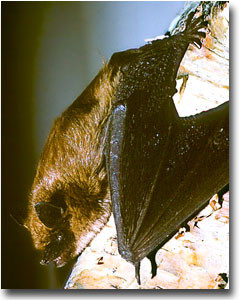Slowing the spread

The fungus that causes White-nose Syndrome was detected in Alberta in 2022.
White-nose Syndrome is a disease that affects bats; it is caused by a fungus found in the caves where bats hibernate.
Since the discovery of the disease in New York, in 2006, millions of bats have died. The fungus irritates the bats and causes them to arouse from hibernation. The bats quickly burn through their stored fat – and in the absence of insect prey – they starve to death. Some bat populations have declined by 90%.
Now that the fungus has been detected in Alberta, we expect to see it spread. We anticipate that Alberta’s hibernating bat species will experience severe population declines in the coming years.
What you can do
We cannot prevent or eradicate the fungus. However, we can help our bat populations by protecting them and their key habitats. Maintaining places for bats to roost, hibernate and forage will help populations to recover after initial declines; evidence from eastern North America suggests that some species are developing a resistance to the disease. However, recovery will be slow because bats have only one pup per year, and it is unlikely that their populations will return to current levels.
Anyone visiting any caves – particularly those in eastern North America – should be aware of basic precautions to avoid spreading White-nose Syndrome to new sites. In Alberta, it is illegal to enter a cave where bats are hibernating between September 1 and April 30.
Anyone intending to visit a cave in Alberta is encouraged to be well-informed before visiting such sites:
To learn more about your level of risk for transmitting White-nose Syndrome, and how to disinfect your clothes and gear to prevent further spread, see:
Bats with White-nose Syndrome typically have a white fuzz on their noses, and possibly on their wings, ears or tails. There may also be scarring on their wings.
If you see a bat flying in the winter, or find a dead bat in the winter or spring with signs of White-nose Syndrome, please contact a biologist at the nearest fish and wildlife office to arrange to bring the bat in for testing:
White-nose Syndrome does not affect other animals or people. However, to be safe, use something disposable to place the bat into a bag, such as medical gloves and tissues.
Alberta cave closures
The following cave closures have been issued to prevent the spread:
Posters have been placed at the trailhead access for Cadomin and Wapiabi caves:
News
Other preventative measures in Alberta
In Alberta, we are being proactive in informing the public about the concerns over – and in limiting the potential for – the human transfer of the fungus.
Similarly, in 2014, a cooperative effort among Alberta and B.C. government staff, along with input from Alberta and B.C. caving groups, Parks Canada, the Canadian Cooperative Wildlife Health Centre and the U.S. Fish and Wildlife Service resulted in guidelines for limiting the potential transfer of White-nose Syndrome during caving activities in Western Canada.
Following 5 years of temporary access restriction to the Cadomin and Wapiabi caves, the primary known bat hibernacula in Alberta, the situation was reviewed in 2015. Much has been learned about the fungus and about White-nose Syndrome; however, the risk to bat populations remains significant. As a result, access restrictions were extended until there is definitive evidence to support re-opening or limited use of closed caves.
We also have amended the provincial standards for bat handling procedures in Alberta. See the 'Addendum to class protocol #4: Bat Capture, Handling and Release' at:
In March 2016, the concerns and precautions were summarized in a revised cave advisory:
Related information
- Community bat program
General information about Alberta's bat species. - White-nose Syndrome
Primary online source of information about the syndrome. - Bat Health
Information from the Canadian Wildlife Health Cooperative. - White-nose Syndrome Surveillance
Information from the United States Geological Survey National Wildlife Health Center.